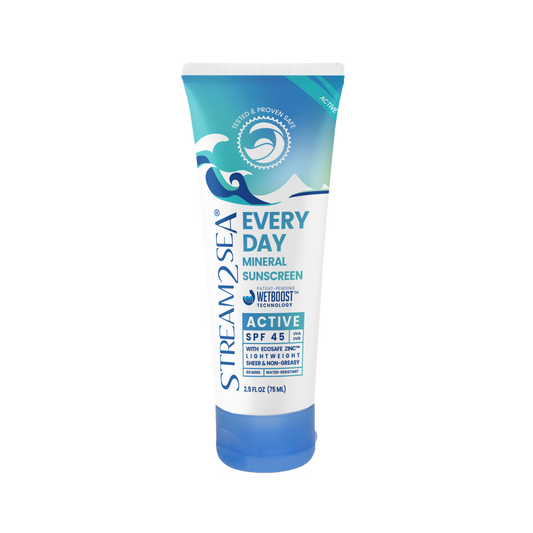Oxybenzone, Avobenzone, Octinoxate, and more Sunscreen Ingredients to Avoid

OXYBENZONE HOMOSALATE OCTINOXATE OCTOCRYLENE NANO ZINC
AVOID HARMFUL INGREDIENTS CHOOSE THE PROVEN SAFE MINERAL SUNSCREEN
Are Your Sunscreen and Body Care Products Truly Reef Safe and Human Safe?
-
Did you know there are no federal regulations defining terms like "natural," "green," "biodegradable" or "reef safe" in
sunscreens, skincare, or cosmetics?
Many brands use misleading marketing, adding a tiny amount of a so-called "safe" ingredient while still including harmful chemicals—putting both your health and marine ecosystems at risk. -
To protect yourself and our waters, always read the ingredients label, not just the front of the package. Below, we've compiled a growing list of toxic ingredients commonly found in sunscreens and body care products — many of which have been linked to coral bleaching, hormone disruption, and skin irritation.
Make informed choices for a reef safer, people safer future. -

FREE Ingredients to Avoid Card
Download here
List of Harmful Chemicals in Sunscreen and Body Care Products
Benzophenone-3, also known as Oxybenzone
Health HazardEco Hazard
A very common ingredient in FDA approved sunscreens. Very effective at reducing UV exposure, it is also classified as a hazardous irritant for eye contact and slightly hazardous for direct skin contact. (https://haereticus-lab.org/oxybenzone-2/). This ingredient penetrates the skin and is also used to help other chemicals penetrate the skin. According to the Center for Disease Control (CDC), 97 percent of Americans have this chemical circulating in our bodies. Also listed as a direct cause of coral bleaching by Robert Davanero et al – there is strong cause to avoid all products using this ingredient: (http://www.ncbi.nlm.nih.gov/pmc/articles/PMC2291018/)
Avobenzone
Health Hazard Eco Hazard
A very common ingredient in FDA approved chemical-based sunscreens. Avobenzone is often used to replace Oxybenzone in ‘Hawaii Compliant’ sunscreens. This ingredient penetrates the skin, is a severe eye irritant and allergen. Highly unstable in the presence of UV light, it photodegrades with exposure to sunlight, increasing free radicals in the skin. Learn more https://stream2sea.com/what-is-avobenzone/ and https://www.ncbi.nlm.nih.gov/pubmed/19856938
Butyloctyl Salicylate
Eco Hazard
A new ingredient of emerging concern that is being added to even ‘natural’ sunscreens to achieve a higher SPF rating. A synthetic ingredient that help to disperse both mineral and chemical sunscreen actives, butyloctyl salicaylate is considered a class 4 chronic aquatic toxin. Learn more here
Cylcopentasiloxane / Cyclomethicone
Health Hazard Eco Hazard
Silicone-based ingredients that are used in skin and hair care products. They soften the skin and smooth hair follicles, but they’ve also been shown to be toxic and to bio-accumulate in aquatic organisms. They are also suspected to be reproductive toxins and endocrine disruptors.
Formaldehyde, Diazolidinyl urea, Quaternium-15, DMDM Hydantoin and Hydroxymethylglycinate
Health Hazard Eco Hazard
Formaldehyde – you won’t see formaldehyde listed on any of your personal care products, but many of the preservatives that have been used as paraben replacements RELEASE formaldehyde! Diazolidinyl urea, Quaternium-15, DMDM Hydantoin and Hydroxymethylglycinate are all formaldehyde releasers. The International Agency for Research on Cancer has classified formaldehyde as a human carcinogen. It is also an ecotoxin.
Homosalate
Health Hazard
Another very common sunscreen ingredient that, for health concerns, is limited to less than 10% in a formula by the FDA. It’s used as a UV absorber that helps sunscreen ingredients penetrate your skin. It bio-accumulates in the body faster than it can be eliminated and is considered a hormone disruptor.
A recent opinion from the European Commission found that homosalate was not safe to use at concentrations up to 10 percent and recommended a maximum concentration of 1.4 percent, because of concerns for potential endocrine disruption (SCCS 2020).
Methylisothiazolinone
Health Hazard Eco Hazard
A widely used and very effective preservative. It is considered a sensitizer and irritant, is associated with allergic reactions, and lab studies are suggesting that it may be a neurotoxin. It is also considered an ecotoxin.
Microbeads
Eco Hazard
Most commonly used in cleansers and exfoliants, but also found in other personal care products like toothpastes. Because they are so fine, most wastewater treatment plants cannot filter these and they end up in the environment. These have been found in fish and other aquatic species.
Nanoparticles
Eco Hazard
These are insoluble or biopersistent materials with a size of 1 to 100 nanometers, which can be up to 100,000 times smaller than a human hair! Nanomaterials can react in the body and environment differently from the same material that is non-nano. Although manufacturers have stated that nanoparticles are safe, there are still concerns among scientists. A recent study has shown that zinc oxide nanoparticles, even in extremely low concentrations, caused significant developmental disorders in sea life (http://pubs.acs.org/doi/abs/10.1021/acs.est.5b00345). When nano sunscreens wash off people’s bodies, they can harm our environment. If you are using a mineral sunscreen, zinc or titanium, make sure it is non-nano grade.
Octocrylene
Health Hazard
A synthetic UV absorber and SPF booster. It may cause allergic reactions in those with sensitive skin and has been shown to bio-accumulate in the body.
Found in almost 3,000 products sold in the United States, Octocrylene quickly degrades into benzophenone, a known carcinogen that also causes contact dermatitis and is an endocrine disruptor. Learn more here
Octinoxate / Octyl methoxycinnamate
Health Hazard Eco Hazard
Also a commonly used UV filter approved by the FDA for use in sunscreens. It is absorbed through the skin and has been found in human urine, blood and breast milk, showing that it is systematically absorbed. It is an endocrine disruptor that can mimic hormones. Also listed as a direct cause for coral bleaching by Robert Davanero et al – there is strong cause to avoid all products using this ingredient: http://haereticus-lab.org/octinoxate/
Parabens
Health Hazard Eco Hazard
Including propylparaben, benzylparaben, methylparaben and butylparaben are commonly used to prevent the growth of bacteria, yeast and molds in personal care products like shampoos, lotions and sunscreens. These ingredients can mimic the hormone estrogen which has been known to contribute to breast cancer and can also mimic other hormones in the body. The good news is that many brands, including many in the main-stream, have recognized the cause for concern and will clearly label their products as ‘paraben-free’, but many still use this effective and inexpensive preservative. Read your labels, friends!
Phthalates
Health Hazard
Commonly found in synthetic fragrances, block male hormones and can interfere with normal genitalia development. High levels can cause sluggish sperm and low testosterone levels in adult males. These are also classified as endocrine disruptors that can interfere with normal brain function. Although this doesn’t guarantee there are no phthalates in the formula, look for fragrances that are designated as ‘natural’ or derived from essential oils. Some companies will also state phthalate free on their labels or in their marketing literature.
Quaternium-15
Health Hazard
A very effective, broad antimicrobial ingredient preservative that is suspected to be a formaldehyde releaser. Used in low concentrations, it is still classified as a skin, eye, and respiratory irritant. According to SafeCosmetics.org: The North American Contact Dermatitis Group considers quaternium-15 to be among the most clinically significant contact allergens in children.
Retinyl Palmitate
Health Hazard
Often found in many cosmetics and skin care products, is composed of palmitic acid and retinol (Vitamin A). When exposed to UV light (or sunshine), retinol compounds break down and produce toxic free radicals that can damage the skin. The FDA has raised concern that extensive, daily skin application of vitamin A creams may build up a high enough level of Vitamin A that may be toxic to a developing fetus.
Sodium lauryl and laureth sulfate (SLS/SLES)
Health Hazard Eco Hazard
A surfactant, detergent and emulsifier that creates lots of lather in shampoos and body washes. Although SLS is ‘derived from coconuts,’ the resulting molecule is VERY different from any coconut we’ve ever seen. A quick look at the ingredient’s MSDS sheet shows lots of potential for concern. They have been mentioned in nearly 16,000 studies in the PubMed science library about the toxicity of this chemical. Although the suppliers maintain that actual health risk varies based on the level of exposure to the ingredient, we maintain that it is the gradual, long term exposure that really counts and encourage you to avoid using this ingredient in any of your body care products. https://davidsuzuki.org/queen-of-green/dirty-dozen-sodium-laureth-sulfate/ If that wasn’t enough to deter you, SLS is also listed as ‘toxic to aquatic organisms’ http://www.pesticideinfo.org/Detail_Chemical.jsp?Rec_Id=PC35205
Zinc Oxide
Eco Hazard
Yes, Zinc is found naturally in the environment and in seawater; however, we are suggesting that you use extreme caution when choosing zinc based sunscreens that are promoted as ‘clear’ or ‘transparent.’ Some of these dispersions have the ability of offering a transparent zinc without having to use nanoparticles. BUT if you review the MSDS sheet of these materials – even the all natural version used in natural products – they are all listed as marine pollutants and have ‘a component listed as highly toxic to aquatic organisms.’ Some of these have ‘Attention! Highly toxic to fish and/or other aquatic organisms’ listed on first page of MSDS, others are buried under Section 12 of the MSDS sheet.
The EcoSafe Zinc™ we use in our EcoSticks is non-nano, naturally-coated, USP grade and Cosmos certified. All zinc is NOT created equally, and ours is the only zinc we have identified that has passed rigorous aquatic safety testing
Stream2Sea
Free: Ingredients to Avoid Card
Share

Reef Safer* Sunscreens
-
Coral Care SPF 30
13 reviewsRegular price $26.95Regular price -
Every Day Active Mineral Sunscreen
176 reviewsRegular price $26.95Regular price -
Every Day Shimmer Mineral Sunscreen
100 reviewsRegular price $28.95Regular price -
Water Sport Sunscreen SPF 30
280 reviewsRegular price $18.95Regular price
![[S2S] After-sun Care](http://stream2sea.com/cdn/shop/collections/SPF30_and_Sun_Sting_Gel.jpg?v=1764789810&width=1500)





